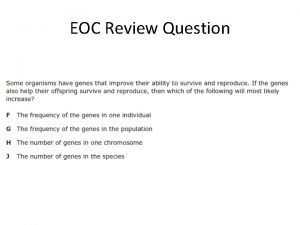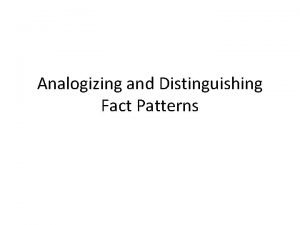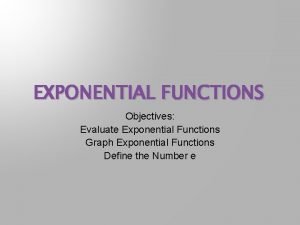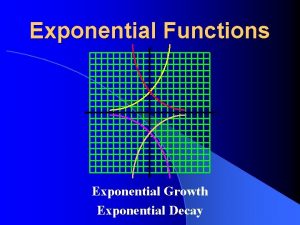EOC Review Distinguishing Exponential Linear from Context Exponential










- Slides: 10

EOC Review: Distinguishing Exponential & Linear from Context

Exponential or Linear? Sometimes we need to identify whether word problem is describing data that follows an exponential or a linear pattern. Look for key words. If no table is given, make one!

KEY TERMS EXPONENTIAL LINEAR • GROWTH/DECAY • CONSTANT PERCENT RATE • EACH, EVERY, RATE, PER • CONSTANT RATE OF • DOUBLES/HALVES • SLOPE OF CHANGE

TABLE PATTERNS EXPONENTIAL LINEAR • LOOK FOR A CONSTANT • (*sometimes will look like MULTIPLYING PATTERN dividing because it is multiplying by a fraction) ADDING PATTERN subtracting because it is adding a negative)

Example: E#1. 1 Which choice could be modeled by an exponential function? Notice the question asks for exponential. Look for key words in the descriptions. • A. the speed of a car that is increasing by 5 mph every minute • B. the number of sit ups a person does each day if the number of sit ups increases by 2 each day • C. the amount a person gets paid if the person’s pay increases by 3 percent each year • D. the number of students in a class with no withdrawals or additions

Look for key words in the question. What type of function does that indicate? Example E#1. 2 Make a table to check which percent is correct. A scientist studying a population of birds discovered that the number of birds doubled every year. Which function would best represent this situation? A. linear function with a rate of change of 200% every year B. linear function with a rate of change of 100% every year C. exponential function with a growth rate of 200% every year D. exponential function with a growth rate of 100% every year Yr # of birds 1 2 3 40 80 160 Find percent rate of change: (80 – 40)/40 = 100% (160 -80)/80 = 100%

You Try! • Mark key terms. • Look for patterns in the table.

Check it E#1. 3 • Trusha is creating a savings plan a trip to her aunt’s. Which situation could be represented by an exponential function? • • A. Trusha saves $10 each week. B. Trusha saves 10% of her paycheck each week. C. Trusha saves $5 each week, plus 10% of her paycheck D. Trusha saves $2 the first week, $4 the second week, $8 the third week, and so on.

Check it: E#1. 4 The value of a 1980 vintage Ninja Turtle action figure was $20 in 1990, $60 in 2000, and $180 in 2010. Which type of function best models the value of the action figure x years after 1990 and why? A. a linear function because the value of the land increases at a constant percent rate every 10 years B. an exponential function because the value of the land increases at a constant percent rate every 10 years C. a linear function because the value of the action figure increases by a constant amount every 10 years D. an exponential function because the value of the action figure increases by a constant amount every 10 years

Check it: E#1. 5 A pickelball tournament starts with 120 players. During each round of play, half of the players are eliminated from the tournament. What type of function best models the relationship between the number of players in the tournament, y, and the round of play, x? A. exponential decay model B. exponential growth model C. linear model with positive slope D. linear model with negative slope
 Florida us history eoc review
Florida us history eoc review Pbs eoc review
Pbs eoc review Who helped build the transcontinental railroad
Who helped build the transcontinental railroad Us history eoc review notebook
Us history eoc review notebook This area along the german/belgian border was demilitarized
This area along the german/belgian border was demilitarized 11 grade us history eoc review
11 grade us history eoc review The teapot dome scandal centered around *
The teapot dome scandal centered around * Physical science eoc practice test
Physical science eoc practice test Physical science eoc review
Physical science eoc review Hbs practice test
Hbs practice test Civics 360
Civics 360



















